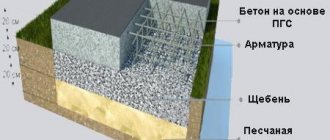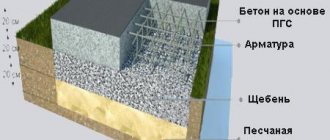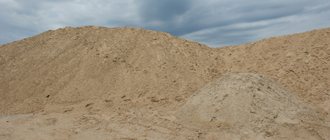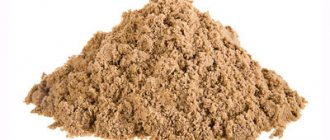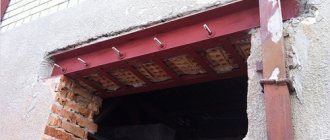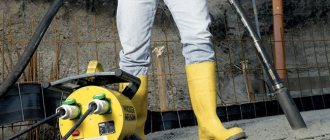When choosing crushed stone, it is important to take into account such an indicator as the compaction coefficient. This criterion shows how much the volume of material can be reduced while maintaining the same mass due to compaction or natural shrinkage. This indicator is used to determine the amount of aggregate, both during purchase and directly during the construction process.
Due to the fact that after compaction the bulk weight of crushed stone of any fraction will increase, it is necessary to immediately take into account the supply of material. And in order not to buy too much, a correction factor is needed.
The compaction coefficient (Ku) is a very important indicator, which is necessary not only for the correct ordering of materials, but also in order to provide for further shrinkage of the gravel layer after it is loaded with building structures. Moreover, knowing the compaction coefficient, it is possible to predict the stability of the construction projects themselves. Due to the fact that the compaction coefficient is, in fact, the degree of volume reduction, it can vary depending on 4 factors:
- Loading method and parameters (for example, from what height the backfill is performed).
- Features of the transport by which the material is delivered to the site, and the distance to the construction site - after all, even a stationary mass gradually becomes denser as a result of subsidence under its own weight.
- Crushed stone fractions and grain contents are smaller than the lower limit of a specific crushed stone class.
- Flakiness - needle-shaped stones shrink less than cuboid stones.
It should be remembered that the strength of concrete structures, building foundations and highways directly depends on the accuracy of determining the degree of compaction. However, we should also not forget that compaction on site is often performed only on the top layer, and in this case the calculated coefficient does not always correspond to the actual shrinkage of the base. This happens especially often when construction is carried out not by professionals, but by amateurs. In accordance with technology requirements, each layer of backfill must be rolled and checked separately.
Another parameter that must be taken into account is that the degree of compaction is calculated for a mass that is compressed without lateral expansion, that is, limited by the walls, which prevents it from spreading. At the site, such conditions for backfilling any fraction of crushed stone are not always created, so a small error remains. This fact should be taken into account, first of all, when calculating the settlement of large structures.
Sealing during transport
It should be noted that finding a standard compressibility value is actually not easy, since too many factors influence it. (All of them are listed above). The supplier may indicate the crushed stone compaction coefficient in the accompanying documentation, although GOST 8267-93 does not directly require this. However, when transporting gravel, especially large quantities, there are often significant differences in volumes when loading and at the construction site where it was delivered. Therefore, the correction factor, which takes into account the compaction of crushed stone, must be included in the contract and controlled at the reception point. The only mention in the current GOST: the compaction coefficient, regardless of the fraction, should not be higher than 1.1. Suppliers are certainly aware of this, and in order to avoid returns, they try to keep a small supply. Measurements are often resorted to during acceptance, when crushed stone is delivered to the construction site, since it is ordered not in tons, but in cubic meters. To do this, the truck body with the crushed stone in it must be measured from the inside with a tape measure, then the volume of gravel delivered must be calculated, and then multiplied by a factor of 1.1. This calculation will allow you to approximately determine how many cubes were poured into the back of the truck before shipment. If the figure obtained taking into account the compaction is less than that indicated in the accompanying documents, it means that the car body was underloaded. Equal to or greater than that indicated in the documents, you can safely unload the crushed stone.
How to use the coefficient correctly
An important stage in any construction work is the preparation of all estimates with mandatory consideration of the compaction coefficients of bulk materials. This must be done in order to include the correct and necessary amount of building materials in the project and avoid their excess or shortage.
How to use the coefficient correctly? Nothing could be simpler. For example, in order to find out what volume of material will be obtained after shaking in the back of a dump truck or in a carriage, you need to find in the table the required compaction coefficient of soil, sand or crushed stone and divide the purchased volume of products by it. And if you need to know the volume of materials before transportation, then you will need to do not divide, but multiply by the appropriate coefficient. Let’s say that if you purchased 40 cubic meters of crushed stone from a supplier, then during transportation this amount will turn into the following: 40 / 1.15 = 34.4 cubic meters.
| Table of compaction coefficients for bulk building materials | |
| Type of material | Coupl (compaction coefficient) |
| PGS (sand and gravel mixture) | 1.2 (GOST 7394-85) |
| Sand for construction work | 1.15 (GOST 7394-85) |
| Expanded clay | 1.15 (GOST 9757-90) |
| Crushed stone (gravel) | 1.1 (GOST 8267-93) |
| Priming | 1.1-1.4 (according to SNIP) |
| All values given in the table are statistical averages and may vary depending on the specific conditions of delivery, storage and composition of the material. | |
Work related to the complete chain of movement of sand masses from the bottom of the quarry to the construction site must be carried out taking into account the relative reserve factor of sand and soil for compaction. This is a value that shows the ratio of the weight density of the solid structure of the sand to its weight density at the supplier's shipping area. To determine the required amount of sand to ensure the planned volume, you need to multiply this volume by the relative compaction coefficient.
In addition to knowing the relative coefficient given in the table, the correct use of GOST implies mandatory consideration of the following factors for the delivery of sand to the construction site:
- physical properties and chemical composition of the material inherent in a particular area;
- conditions of transportation;
- taking into account climatic factors during the delivery period;
- obtaining values of maximum density and optimal humidity in laboratory conditions.
Compaction on site
Please note that the above figure - 1.1 - is taken into account only during transportation. At a construction site where crushed stone is compacted artificially, using a vibrating plate or roller, this coefficient can increase to 1.52. At the same time, performers need to know exactly the degree of shrinkage of the gravel backfill. Usually this parameter is listed in the design documentation. However, if there is no need for an exact value, use the average indicators specified in SNiP 3.06.03-85:
Crushed stone of fraction 40-70, as a rule, has a compaction of 1.25-1.3 (if its grade is not lower than M800). Up to M600 – from 1.3 to 1.5. For small and medium classes of 5-20 and 20-40 mm, these indicators have not been established, since they are often used only when clinching the upper load-bearing layer of grains 40-70.
What crushed stone is needed in different cases
Soil compaction with crushed stone is used when it is necessary to build a specific house. Thanks to this technological process, it is possible to complete all the assigned tasks without causing subsidence of subsequent layers. If the compaction process is not carried out correctly, then over time the layer of crushed stone and compacted soil will form a cage. As a result, cracks will form on the surface.
What is the significant difference between gravel and crushed stone is indicated in this article.
Tamping material
Compacting crushed stone is a mandatory activity for those who want to get a strong and high-quality foundation when constructing roads and buildings. To perform compaction it is necessary to use special equipment. Most often, a roller or vibrating plate is used. If the volumes are small, the material can be compacted manually.
It is necessary to check the quality of the installation using a special device. These measures are considered mandatory, otherwise poor-quality compaction will lead to a lot of trouble. During the measurement, it is necessary to determine the degree of compaction. This is done using the dynamic sensing method.
What is the specific gravity of crushed stone 40 70 can be found in this article.
The essence of the technique is that several blows are applied to the surface with the surface of the disk. It allows you to determine the cage. After all measurements have been completed, it is necessary to evaluate the results. When they are all within normal limits, then further compaction of the next layers of material can be performed.
What GOST 8736 93 sand is is described in this article.
Laboratory research
The compaction coefficient is usually calculated based on laboratory test data, during which a mass of crushed stone is compacted and tested on various devices. There are several methods here: volume replacement (GOST 28514-90); standard layer-by-layer compaction of crushed stone (GOST 22733-2002); express methods using one of three types of density meters: static, water balloon or dynamic.
Results are obtained either immediately or after 1-4 days, depending on which research method is chosen. The cost of one standard test sample is 2,500 rubles. In total, at least five such tests must be carried out. If data is needed urgently, for example, during the day, express methods are used based on the results of selecting at least 10 points. The cost of each point is 850 rubles. In addition, you will have to pay for a laboratory technician to travel to the site - about another 3 thousand rubles. However, it is impossible to do without accurate data during the construction of large projects. In addition, a reputable construction organization needs to have official documents that confirm the contractor's compliance with the project requirements.
Application area
ASG is used in the construction of foundations for highways, foundation cushions, backfilling of pits and backfilling of embankments.
In the construction of railways, ballast mixtures are used in accordance with GOST 7394-85, consisting of sand and gravel or only gravel.
Natural wood chips are used in road construction.
ALP made from crushed building materials is used in the production of concrete, as well as in bedding and foundations during the construction of buildings.
Is it possible to find out the degree of compaction yourself?
Yes, the coefficient can be determined both in the field and for the needs of private construction. To do this, you must first find out the bulk density for each size: 5-20, 20-40, 40-70. It directly depends on the mineralogical composition of the material, but it is insignificant. Crushed stone fractions have a much greater influence on the volumetric weight. For calculations, you can use averaged data:
More accurate density data for a specific fraction of crushed stone can be determined in the laboratory or by weighing a known volume of building crushed stone, followed by a simple calculation:
Bulk weight = mass/volume.
After this, the mixture is rolled to the state in which it will be used on the site and measured with a tape measure. And then they again calculate the formula given above, resulting in 2 different densities - before and after compaction. By dividing both numbers, we obtain the compaction coefficient for a specific material. If the sample weights are the same, you can simply find the ratio of the two volumes - the result will be similar. It should be noted that if the indicator after compaction is divided by the initial density, then the number obtained in the answer will be greater than one - in fact, this is the material reserve factor for compaction. In construction, it is used if the final parameters of the gravel bed are known and for ordering it is necessary to determine the amount of crushed stone of the selected fraction. When calculated back, the result is a value less than one. However, these numbers are equivalent and when making calculations it is important to understand which one should be taken.
Order
- 8-499-113-21-11
Technical features of crushed stone
The construction industry uses various types of crushed stone with different properties.
granite crushed stone takes the leading position
. It is extracted from rocks by crushing. Granite is a very hard and dense material. The universal fraction of such crushed stone is considered to be 5-20 mm. It can be used in any work.
No less popular among builders is crushed gravel.
. It is obtained by crushing rocky rocks. It is somewhat inferior in strength to granite crushed stone, but at the same time slightly cheaper in cost.
Another option for crushed stone is limestone.
. Extraction is carried out from rock sedimentary rock. Its scope is not as wide as that of the first two. But still, there is also a demand for it. It is used in the glass industry and in the preparation of cement mixtures.
Crushed stone
- Packed crushed stone in bags (50 kg)
Storage of bulk materials
Crushed stone, sand, crushed stone-sand mixtures are stored separately from each other. Measures are taken to protect stored materials from contamination. The best option is storage in a closed warehouse. There the materials are protected from wind and precipitation.
During long-term storage, compaction occurs during storage of sand, as well as crushed stone and ASG.
The rate of natural loss of materials is regulated by the RDS 82-2003 standard.
Loss rates for bulk storage are measured as a percentage of the mass:
- crushed stone, gravel - 0.4%;
- sand - 0.7%;
- PGS - 0.45%;
- dropout rate - 0.75%.
When shipping materials, these indicators are taken into account.
Sand and gravel mixture is a popular material. It is used in industrial, road, and country construction. The information from the article will help you correctly calculate the need for this raw material.
What is it needed for?
When delivering crushed stone to an object and pouring it into the working area within which it is leveled, the amount of crushed stone compaction comes into play. Its feature is the actual shrinkage of crushed stone poured into a specific place, the layer of which will reach a certain level.
Compaction of crushed stone occurs during delivery - during shaking and vibration, while the dump truck moves to the place where the building material is received. Under the influence of shaking, the pebbles are positioned extremely tightly relative to each other. The voids formed during the initial dumping of crushed stone into the truck become somewhat smaller towards the end of the vehicle's journey, but it is impossible to completely get rid of them.
The compaction coefficient of crushed stone is a value equal to the ratio of the volume established during shaking to the initial volume that the batch of crushed stone just occupied in the body before delivery.
The ratio between the initial and final volume should not be less than 95%. If there is less crushed stone, the customer will resolve the issue of shortfall in crushed stone and adjust the amount to be paid. For example, instead of 20 m3, only 16.5 m3 was delivered to him - the crushed stone crushing percentage was more than 15%. In this case – 17.5%. The initial and final volume values include data about these quantities. When placing an order, the consumer requires that these values be displayed - otherwise the delivery person will end up unwittingly deceiving the customer.
